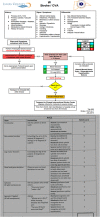Stroke care: initial data from a county-based bypass protocol for patients with acute stroke
- PMID: 27342763
- PMCID: PMC5520240
- DOI: 10.1136/neurintsurg-2016-012476
Stroke care: initial data from a county-based bypass protocol for patients with acute stroke
Abstract
Background: Early identification and transfer of patients with acute stroke to a primary or comprehensive stroke center results in favorable outcomes.
Objective: To describe implementation and results of an emergency medical service (EMS)-driven stroke protocol in Lucas County, Ohio.
Method: All county EMS personnel (N=464) underwent training in the Rapid Arterial oCclusion Evaluation (RACE) score. The RACE Alert (RA) protocol, whereby patients with stroke and a RACE score ≥5 were taken to a facility that offered advanced therapy, was implemented in July 2015. During the 6-month study period, 109 RAs were activated. Time efficiencies, diagnostic accuracy, and mechanical thrombectomy (MT) outcomes were compared with standard 'stroke-alert' (N=142) patients from the preceding 6 months.
Results: An increased treatment rate (25.6% vs 12.6%, p<0.05) and improved time efficiency (median door-to-CT 10 vs 28 min, p<0.05; door-to-needle 46 vs 75 min, p<0.05) of IV tissue plasminogen activator within the RA cohort was achieved. The rate of MT (20.1% vs 7.7%, p=0.06) increased and treatment times improved, including median arrival-to-puncture (68 vs 128 min, p=0.04) and arrival-to-recanalization times (101 vs 205 min, p=0.001) in favor of the RA cohort. A non-significant trend towards improved outcome (50% vs 36.4%, p=0.3) in the RA cohort was noted. The RA protocol also showed improved diagnostic specificity for ischemic stroke (52.3% vs 30.1%, p<0.05).
Conclusions: Our results indicate that EMS adaptation of the RA protocol within Lucas County is feasible and effective for early triage and treatment of patients with stroke. Using this protocol, we can significantly improve treatment times for both systemic thrombolysis and MT.
Keywords: Standards; Stroke.
Published by the BMJ Publishing Group Limited. For permission to use (where not already granted under a licence) please go to http://www.bmj.com/company/products-services/rights-and-licensing/.
Conflict of interest statement
Figures



References
-
- Powers WJ, Derdeyn CP, Biller J, et al. . 2015 American Heart Association/American Stroke Association Focused Update of the 2013 Guidelines for the Early Management of Patients With Acute Ischemic Stroke Regarding Endovascular Treatment: a Guideline for Healthcare Professionals From the American Heart Association/American Stroke Association. Stroke 2015;46:3020–35. 10.1161/STR.0000000000000074 - DOI - PubMed
-
- Jayaraman MV, Iqbal A, Silver B, et al. . Developing a statewide protocol to ensure patients with suspected emergent large vessel occlusion are directly triaged in the field to a comprehensive stroke center: how we did it. J Neurointerv Surg Published Online First: 3 Mar 2016. doi:10.1136/neurintsurg-2016-012275 10.1136/neurintsurg-2016-012275 - DOI - PubMed
Publication types
MeSH terms
LinkOut - more resources
Full Text Sources
Other Literature Sources
Medical
